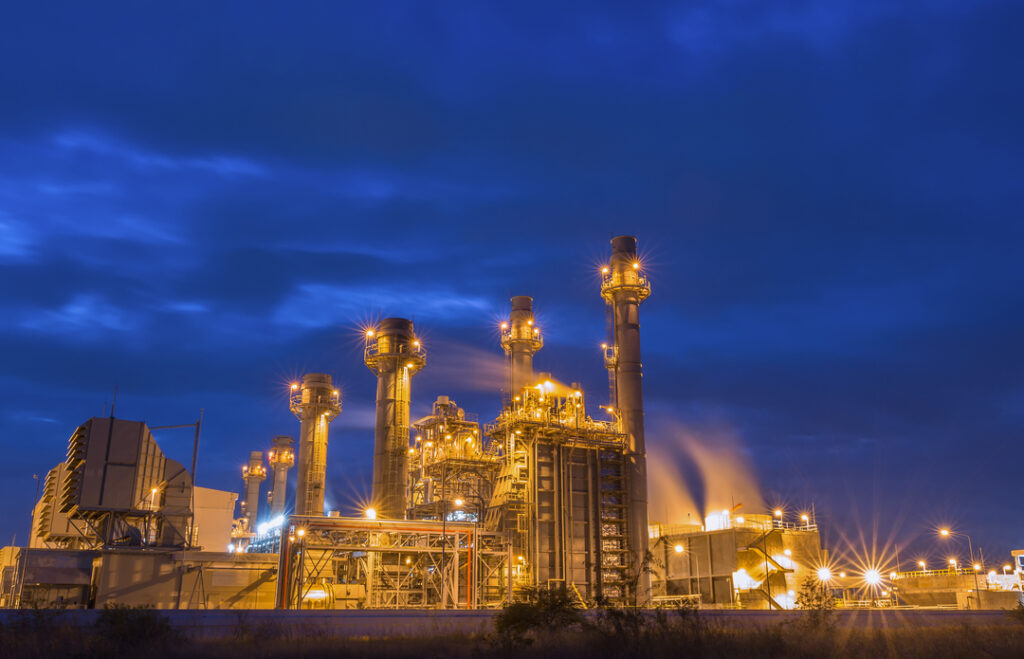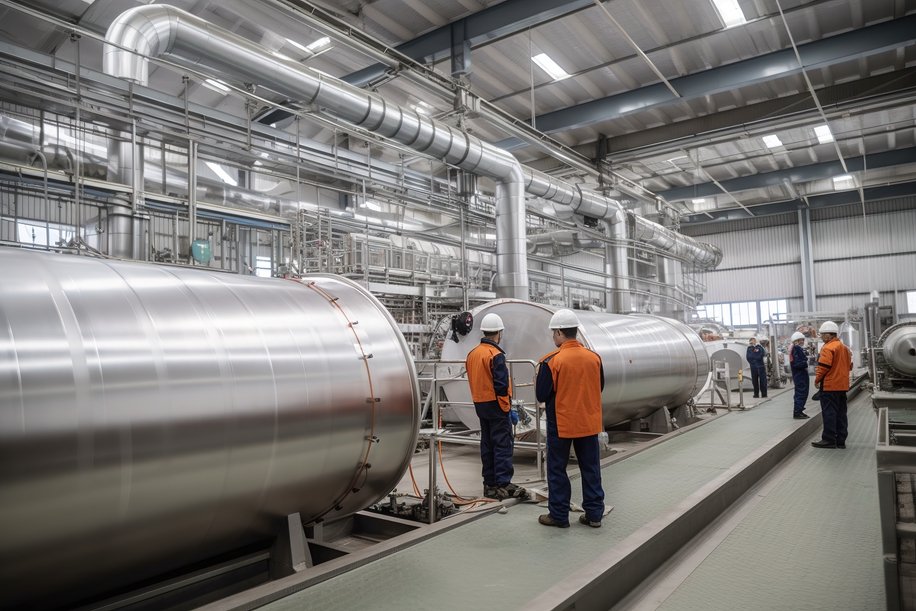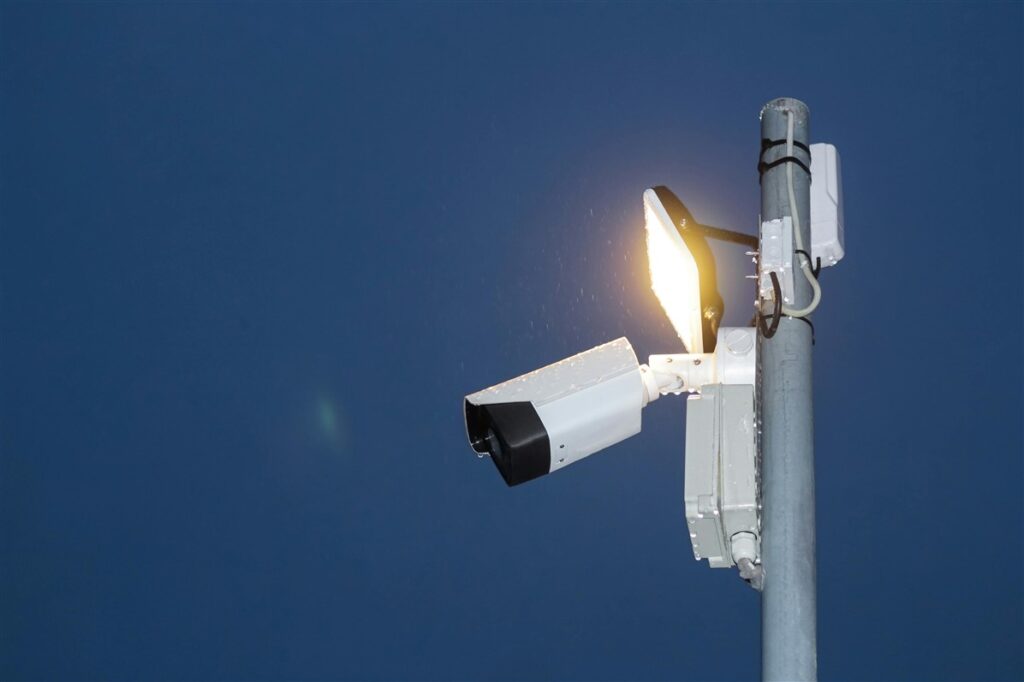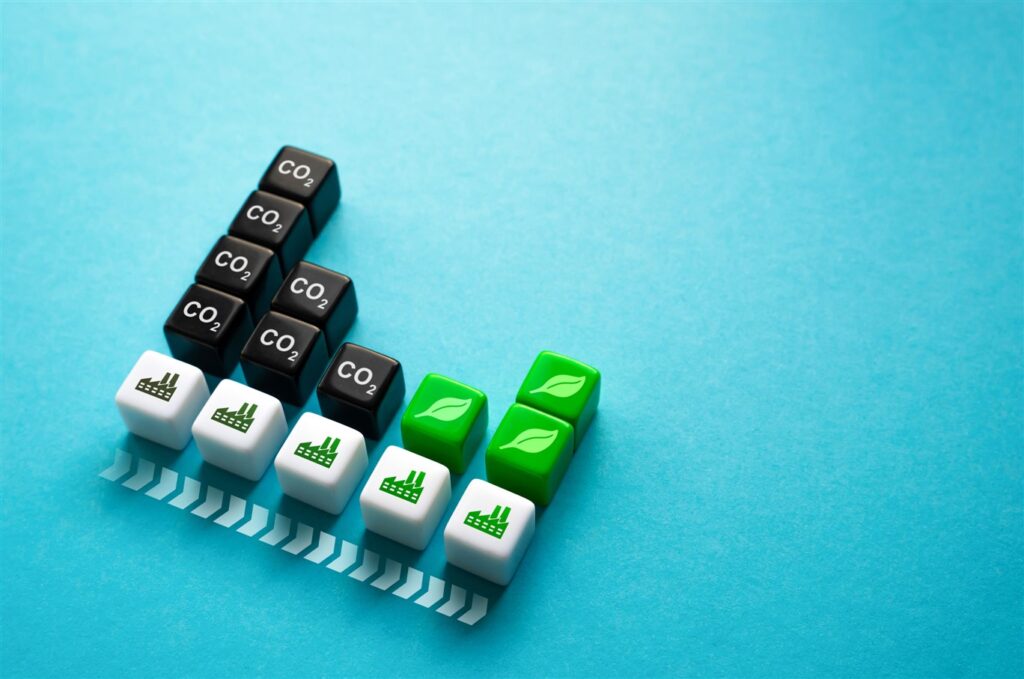Are manufacturers doing enough to reduce energy usage?
Climate change has been a hot topic for years now, and businesses are always under pressure to do their part. But are they doing enough to reduce energy usage?
Are big businesses making big claims without taking action? Have those grand plans for reducing carbon emissions been left on a shelf to collect dust? Are environmental policies nothing more than tick-box exercises?

78% of businesses with over 250 staff do not have a net zero target in place. That doesn’t mean they aren’t making any effort to reduce carbon emissions – they just can’t or won’t commit to net zero.
But something is better than nothing, right? And small wins are better than no wins. So where is the best place to start?
How does your energy efficiency measure up?
There are two key areas where manufacturers can make a difference – material efficiency and energy efficiency.
Material efficiency relates to the products themselves – the materials used in manufacturing them, and the amount of waste produced during production. This should cover the entire product lifecycle from the carbon footprint of every component right through to whether the product can be recycled when it is no longer fit for purpose.
Energy efficiency is focused on reducing the energy used (and wasted). This includes lighting, heating, machinery, transport and so on.
Manufacturers often start with energy efficiency as there are so many areas for improvement, both big and small – lighting upgrades, voltage optimisation, self-generating renewable energy or switching transport fleets to electric vehicles.
But despite the many opportunities to improve efficiency, many non-domestic properties still have a lot of work to do.

How to reduce your energy use
If you want to make a meaningful change, start by being honest about where you are now. Assess your carbon footprint, set realistic targets, and be specific about what action you’re going to take. You won’t achieve net zero overnight, but you can start working towards it.
The less energy used, the better it is for the environment. And the good news is there are plenty of ways to reduce your energy consumption.

Understand your consumption
Start with a thorough and structured assessment of your energy use. Look at every piece of equipment or machinery.
Where are you using the most energy? Where are the greatest inefficiencies? Are areas of your warehouse being lit unnecessarily? Are rooms being heated or cooled even when they are not in use? Where are the biggest opportunities for increased efficiency?
You might be surprised how much energy you could save without making huge investments.
Voltage optimisation
A voltage optimisation system allows you to control and manage the voltage as it comes into the business, distributing the power to the equipment as needed and sending surplus back to the grid.
For older factories, this can cut energy consumption and carbon emissions by 20%, saving you a significant amount of money.
Power factor correction (PFC)
PFC reduces the amount of wasted energy by reducing the load on the electrical distribution system. Capacitors can be added to individual motors, automatically switching in or out of the circuit to counteract the inefficient negative effects.
Energy-efficient motors
Motors and drives are typically the biggest energy consumers on your production line and can account for around a quarter of your power usage. Older motors are often more inefficient than newer models for several reasons, including:
• Higher levels of heat dissipation
• Resistance losses in windings and rotor bar
• Magnetism losses in stator and rotor cores
• Friction losses in bearings
• Cooling fan inefficiencies
• Specific materials used in the manufacture of the motor
Another common cause of motor inefficiency is the motor being much larger than the machinery requires, meaning it uses excessive power. Switching to a smaller motor can significantly reduce energy waste and maintenance costs.
Variable speed drives
A variable-speed drive will make a motor work more efficiently and cut energy consumption by around 50%.
Control and automation
By precisely controlling variables such as material flow, temperature, and power consumption, you can minimise waste and maximise resource efficiency.
Machines also operate with a higher level of accuracy, making them ideal for tasks that require absolute precision. This reduces raw material waste and ensures fewer defective or unsellable products.
Improve insulation
A high proportion of energy is wasted through poor insulation. Replacing and upgrading your wall and ceiling insulation and investing in double or triple-glazed windows can significantly reduce unnecessary energy loss. An air tightness test can quickly identify gaps and leaks in your walls, windows and ceilings.
For new builds or extensions, look for energy-efficient materials. There are plenty of choices for greener construction, and some developers are now favouring more energy-efficient solutions over traditional brick structures.
• Insulated concrete – known to achieve energy savings of approximately 20% against traditional building materials.
• Foam energy bricks – also known as ‘green energy bricks’ are gaining popularity over concrete blocks, insulating sixteen times more effectively, according to some sources.
• Straw – tightly-packed bales create the walls and are coated in plaster to provide insulation.
Heat pumps
Heat pumps transfer thermal energy from one source to another and can be used to heat or cool a building or area.
The most common heat pumps are air-source heat pumps, which absorb heat from the outside air, and ground-source heat pumps, which absorb heat from the ground. But you can also get exhaust air heat pumps, water-source heat pumps, and solar-assisted heat pumps.
Combined Heat and Power (CHP)
CHP systems generate electricity and capture any waste heat produced during the process. The captured heat can be used for heating spaces or hot water, or it can be used in other manufacturing processes. CHP systems are more energy efficient than having separate heat and power supplies.
Re-use waste heat
There are plenty of areas where you can capture waste heat for reuse.
• Boilers
• Furnaces
• Ovens and kilns
• Compressed air systems
• Refrigeration systems and dryers
• Internal combustion engines
• Heat treatment processes
And there are plenty of ways to capture waste heat, including heat pumps, heat exchangers, heat recovery wheels, CHP and absorption chillers. The best solution for you will depend on where you are capturing waste heat and how you want to use it.
Smart thermostats
Older heating systems have two settings for the entire building – on or off. This can cause huge variations in temperature between rooms.
Smart controls allow you to control the temperature of each individual room. Offices and staff rooms can be kept warm in winter and cool in summer, while warehouses and storage areas can be kept at a consistent temperature year-round.
LED lighting
LED lighting has so many benefits that it’s not surprising it’s the top choice for factories and warehouses.
• Energy efficient – reduce energy use and energy cost
• Long-lasting – up to 50,000 hours of light
• Low maintenance – very little ongoing maintenance required
• No heat emissions – better for temperature-sensitive environments
• Versatile – lighting designs can be tailored to the exact needs of your business
• Cost-effective – often delivers ROI through costs saved on energy use
Lighting control
Implementing lighting control systems can reduce energy use by between 30 and 50 per cent and there are plenty of options available:
• Dimmers – ideal for low light requirements, such as during scheduled production downtime or in breakout areas.
• Manual lighting controls – helpful in meeting rooms when hands-on control is required.
• Timed systems – perfect for specific times of the day when you have less staff onsite.
• Movement sensors – can be programmed to operate only when movement is detected in a specific room (such as a toilet or storage room) or an area of a warehouse.
• Daylight sensors/photocells – daylight sensors adjust the lighting according to the natural light in the room.
Battery Energy Storage Systems (BESS)
Battery storage systems can be used to store the energy you purchase at off-peak times and then switched on to distribute energy when tariffs are at their highest. This reduces the amount of energy wasted and lowers your costs.
Battery storage systems can also be configured to work as an uninterruptible power supply. Although they can only store a limited amount of power, they can provide enough for you to safely shut down critical systems or transition to your backup power supply.
Generate your own electricity
Businesses of all sizes can tap into technologies that allow them to generate their own electricity and doing so provides several benefits.
• Reduced energy bills – third-party costs can make up as much as 60% of an electricity bill – if you generate your own, you won’t incur these costs.
• Price protection – when you get electricity from the grid, you’re subjected to price increases or fluctuations – not a problem when you have your own source of power.
• Source of revenue – if you generate excess electricity, it’s possible to sell it to nearby consumers or suppliers.
• Less waste – control how much power you produce and store any excess power to be used at peak times.
• Reduce dependence on the grid – generating some or all your own power reduces your dependence on the grid.
• Reduce carbon footprint – reduce your carbon emissions by using renewable energy.
Wind and solar power are the most viable options for smaller businesses. Wind-solar hybrid solutions are also an option, allowing you to benefit from sunshine in the summer months and make use of the wind during the winter.
Is renewable energy the answer?
Although fossil fuels are still a big fuel source for electricity generation, there are plenty of alternatives. In 2022, 41.5% of all UK electricity was generated from renewable sources.

And it’s only going to get better – technology is constantly being developed to make these renewable sources even more accessible. It’s now possible for us to generate a trillion KWh of electricity from renewable sources in the next five years.

Hydro
Hydroelectricity is generated from water power, with hydro plants usually being built on reservoirs and dams. The benefit of using dams to generate power is they can essentially be turned on and off like a tap to cope with peaks in demand.
Unfortunately, dams and reservoirs take up a lot of space. The most suitable locations have already been utilised, meaning there is little room to further exploit this technology. They can also harm the ecosystem.
Our oceans offer two types of kinetic energy – tides and waves. Neither is being utilised on a large scale, but research and development projects are underway to tap into this energy.
Tides are predictable, so if technology can be developed, it would make it easier to manage demand.
Solar
Solar energy is probably the most reliable source of power as the sun effectively provides unlimited fuel.
Solar energy is also very accessible to businesses that want to generate their own renewable energy since solar panels (or photovoltaics) can be installed on a small scale.
The downside is that solar cells don’t generate any electricity during hours of darkness, meaning you’re at a disadvantage when the days are shorter and there’s greater cloud coverage.
However, newer technologies allow solar energy to be collected and stored, and this technology has the potential for further development, meaning solar energy could become even more accessible in the future.
Wind
Wind power is seeing rapid growth and there is plenty of scope to increase the use of wind for electricity generation.
Turbines are getting bigger and more efficient. And technologies for capturing wind at high altitudes could increase the amount of electricity generated.
Wind power does have limitations, as the infrastructure takes up a lot of space, which isn’t ideal for onshore facilities. Offshore wind farms allow the turbines to be built out at sea, but it’s harder to access the electricity they generate.
However, as the technology is developed further, there may be more opportunities for utilising wind energy.

Bioenergy
Wood, crop residue, and other biological sources were being used for fuel long before fossil fuels became widespread, and they are still widely used today.
Bioenergy (biomass) works well on a small scale, but it is unclear whether it would make a viable solution on a large scale. The effects of biomass dependency could be detrimental to the ecosystem, with large-scale land clearance, pestilence, and drought all posing a threat.
Waste
Waste-to-energy (or energy-from-waste) is the process of generating energy from the treatment of waste, or the processing of waste into a fuel source.
There are different methods used in waste-to-energy, including:
• Combustion or incineration – burning waste to generate heat, which can be used to drive turbines to generate electricity.
• Gasification – turning the waste into a synthesised gas that can be turned into electricity.
• Pyrolysis – the thermal decomposition of materials (usually plastics) at high temperatures in an inert atmosphere.
Using waste to generate energy is preferable to sending it to landfill but isn’t considered as “green” as some other energy sources.
Working with AES
As part of our mission to collectively reduce carbon emissions, we offer free energy reduction audits to manufacturers.
You’ll receive a full report detailing where energy consumption savings can be made and the cost savings to your business.
We also offer energy reduction services specifically for manufacturers. These include:
• Energy efficient lighting
• Voltage optimisation
• Power factor correction
• Variable speed drives
• Control and automation
• Battery Energy Storage Solutions (BESS)
• Electrical vehicle charge points
If you’d like to start your journey to energy efficiency, get in touch to find out how AES can support your sustainability targets.


Our guide to building energy management systems
Building energy management systems (BEMS) are systems that allow you to monitor, control, and optimise the energy used within your building. The phrase building energy management system (BEMS) is often used interchangeably with the phrase building management system (BMS), but there are some differences. A BEMS is focused on energy-related systems such as lighting, heating, […]
Read more
How far does power travel and what impact does distance have on performance
It’s easy to take our electricity supply for granted. We flick a switch and instantly have light or power. We don’t even think about it unless there’s an issue or an outage. But when there is an issue or outage, the impact can be significant. For manufacturers, even the smallest change in power can make […]
Read more
Why visibility of the production process is so important
Operational excellence, efficiency and quality are top priorities for almost every manufacturer worldwide. These things lead to improved productivity, happier customers and reduced waste – all of which result in increased profits. Visibility of the production process is the key to achieving these things. And manufacturers now have access to technology that can provide real-time […]
Read more
Will security lighting help to protect my staff?
Looking after the safety and well-being of employees should be a priority for any business. And while it’s not possible to mitigate every risk, there are measures you can take to improve their safety and security. One measure that is often overlooked is the installation of security lighting. When daylight disappears, visibility is reduced, increasing […]
Read more
Top 5 considerations when comparing electrical quotes
Budget is always a factor when you’re considering any type of upgrade, revamp, or maintenance work within your factory. But when it comes to electrical work, you have to consider more than just money. Don’t rush into accepting the cheapest electrical quotes without knowing exactly what you’re getting. Electrical work is not an area where […]
Read more
What is the role of companies in reducing our carbon footprint?
We should all be taking responsibility for protecting our planet and a big part of that is reducing our carbon footprint. But while it falls to all of us to do our bit, there is additional pressure on manufacturers, especially those with high carbon emissions. As an absolute minimum, these companies should ensure compliance with […]
Read more

